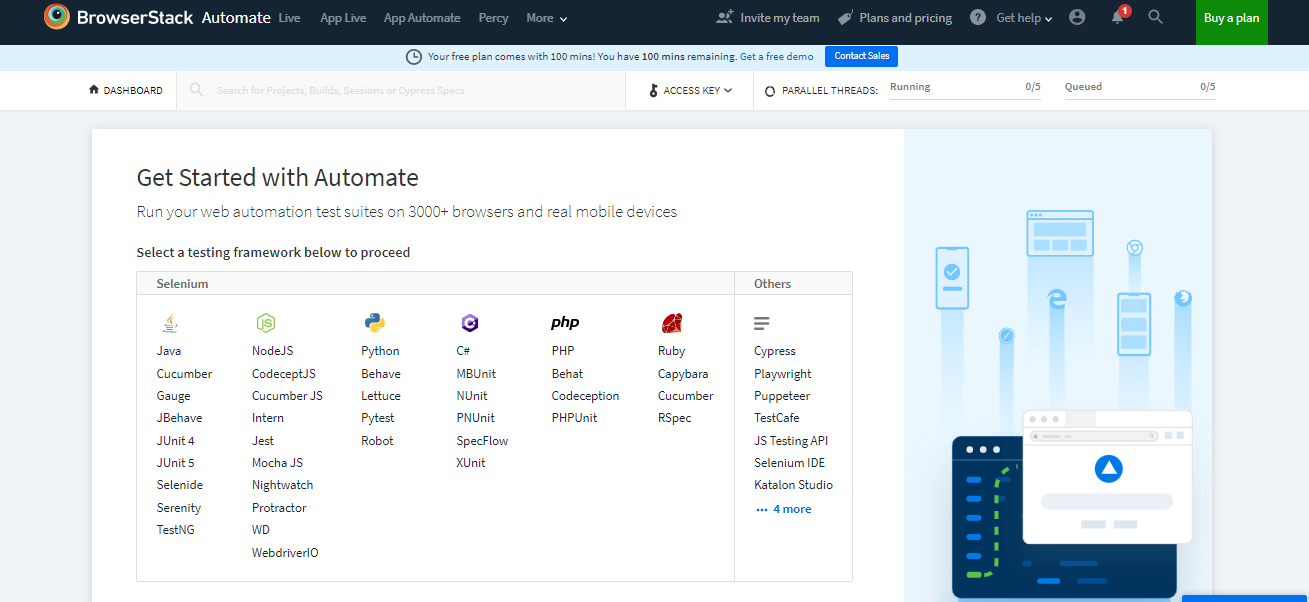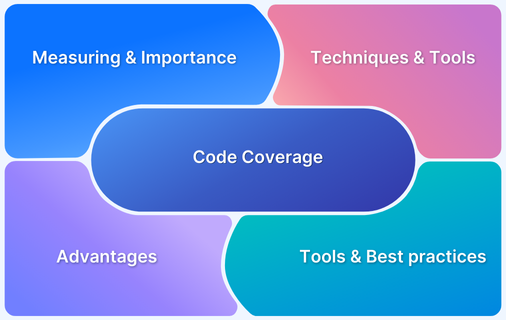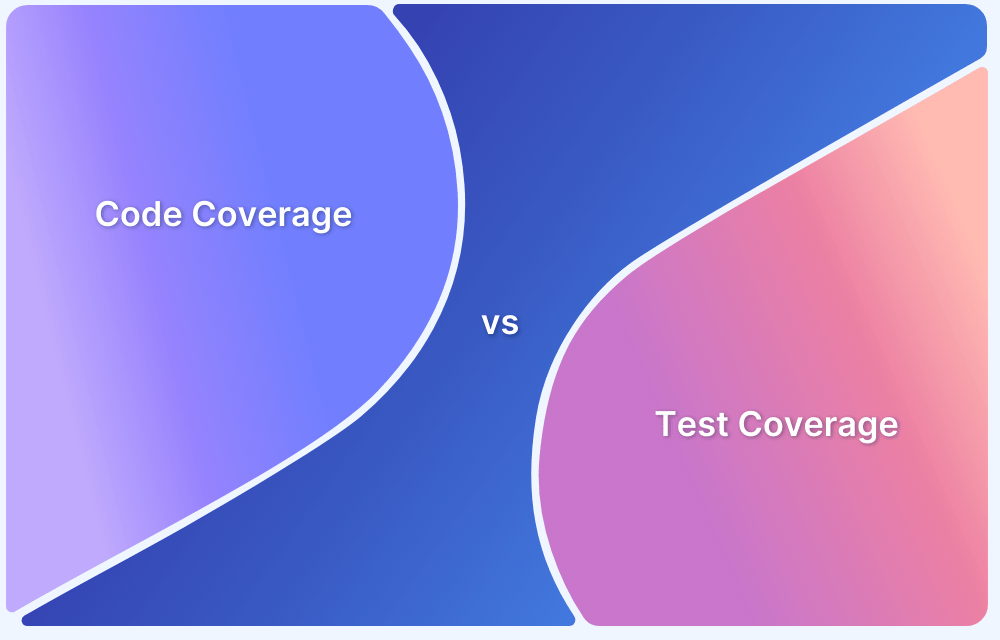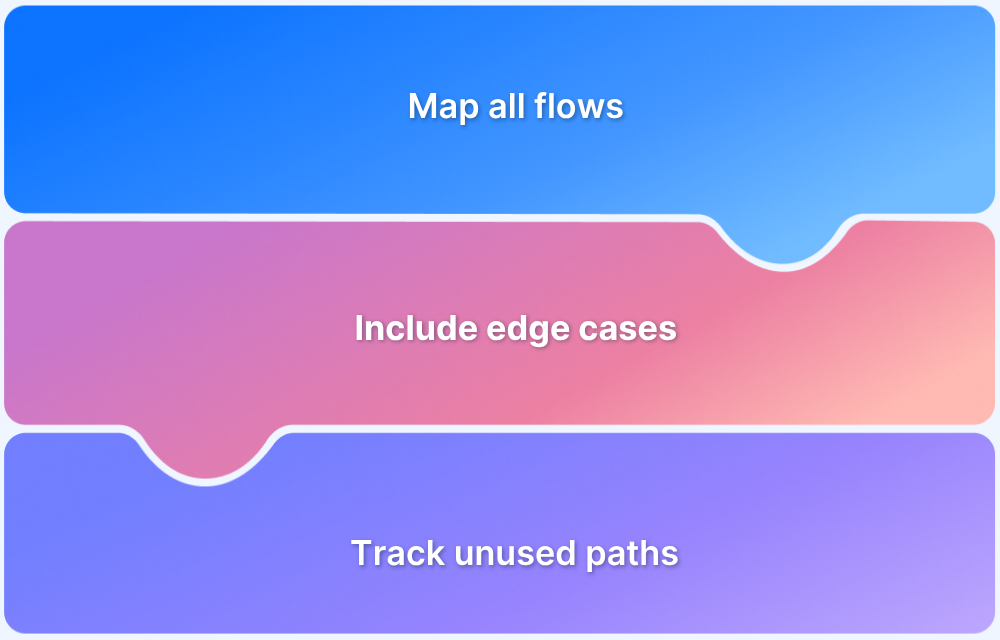The test coverage report provides information about parts of the software where test coverage is being implemented. Essentially, it provides information about the tests executed on an application or website, letting QAs managers make informed decisions about resources, test duration, and other essential parameters. It is a black-box testing technique.
In the following sections, let’s get into the details, types of test coverage, and how a test coverage matrix can streamline your SDLC.
What is Test Coverage?
Test coverage monitors the number of tests that have been executed. Test cases are written to ensure maximum coverage of requirements outlined in multiple documents – FRS (Functional Requirements Specification), SRS (Software Requirements Specification), URS (User Requirement Specification), etc.
- Functional Requirements Specification – Describes the service that the software must offer, the software system, and its components.
- Software Requirements Specification – Describes how the software is expected to perform, as well as the expectations of stakeholders (managers, users, etc.) is must fulfilled.
- User Requirement Specification – Describes what users want/need/expect from the system.
Types of Test Coverage
Here are the types of Test Coverage:
1. Product Coverage
Product coverage answers the question: What product parts have been tested? Let’s take the example of an app that lets users create checklists or to-do lists for each day.
Testers would start by verifying the primary function – the ability to make and save lists. But they have to go beyond this feature to test secondary functions.
- How many lists can be made and saved?
- Can the user set alarms to be reminded of tasks at regular intervals?
- Can the alarm be recurring for tasks that need to be repeated at intervals?
- Can lists be made in multiple languages?
- What happens when an unexpected user action occurs?
Increased product coverage leads to more features and functions being tested for expected performance standards and reveals what is going wrong at what juncture of the user experience.
Read More – Test Coverage Techniques Every Tester Must Know
2. Risk Coverage
Risk coverage evaluates any application’s risks when used by real-world users. Once the risks are known, testing can be structured to ensure that potential risks are not translated into actual negative consequences. When tests are designed to cover said risks, the software stands a much higher chance of attaining technical and commercial success.
- Take an app for stock market investment, for example.
- Let’s say it uses a third-party API to search and retrieve financial data – exchange rates, stock prices, etc.
- If this API becomes unresponsive (a major risk), how would the app respond?
Risk coverage would consider this and design tests accordingly to ensure the software does not become paralyzed and useless if such a risk occurs.
Read More: What is risk-based testing in agile?
3. Requirements Coverage
Before developing any website or app, stakeholders draw up a requirements document that covers what the software seeks to provide its users. In other words, which of its customers’ needs is it fulfilling?
- Think of the app from the last example – the stock market app. It has been comprehensively tested and performs flawlessly in real user conditions.
- But the app gets primarily negative reviews on Google Play Store and App Store. This would confuse its makers.
- With further examination, developers might find they missed out on including some aspects of the requirements document when designing test cases.
- One of them was the ability to automatically deposit profits from a sale to the user’s bank account. The tests missed that this feature has not been incorporated into the app’s features.
Given the competitive nature of the digital market, this is something users are bound to expect. No one will sit around and manually transfer money from an app to their account. Requirements coverage would have ensured that the requirements document was scanned thoroughly and implemented.
4. Code Coverage
It measures how much of the code is executed by the tests.
Subtypes include:
- Statement Coverage: Checks if every line of code runs at least once.
- Branch Coverage: Verifies that every possible branch (e.g., if-else) is tested.
- Condition Coverage: Validates all boolean conditions within logical decisions.
- Path Coverage: Ensures all possible execution paths are tested (more exhaustive).
5. Platform/Device Coverage
Platform/device coverage ensures that the software works reliably across all the environments where users are likely to access it. This includes different operating systems (Windows, macOS, Linux), browsers (Chrome, Safari, Firefox, Edge), and a range of mobile devices (iOS and Android, across various versions and screen sizes).
- Crucial for catching compatibility bugs that appear only on specific platforms.
- Helps ensure consistent UI/UX and functional behavior.
- Often achieved using real device cloud platforms or emulators/simulators.
- Especially important for responsive web and mobile apps targeting diverse user bases.
6. Data Coverage
Data coverage refers to the thoroughness of test inputs — how well the tests account for all relevant values, ranges, types, and edge cases. It ensures that the application handles valid, invalid, extreme, and missing data inputs appropriately.
- Enhances the reliability of form validations, computations, and logic flows.
- Includes testing normal values, boundary values, and edge cases.
- Helps detect crashes, rounding errors, or incorrect business logic triggered by unexpected data.
- Often implemented through data-driven or parameterized testing.
7. User Scenario Coverage
User scenario coverage focuses on validating real-world workflows and use cases that reflect how actual users interact with the application. Instead of isolated tests, it simulates meaningful end-to-end actions like “user signs up, verifies email, and makes a purchase.”
- Prioritizes high-impact user flows based on analytics or business goals.
- Helps identify functional gaps or usability issues in critical workflows.
- Strengthens user confidence by validating tasks they care about most.
- Often aligned with user stories or behavior-driven development (BDD) practices.
How to improve Test Coverage to the maximum?
Here are some of the ways to increase test coverage and maximize it:
Strategize a Test Coverage Matrix
Start with a comprehensive enterprise testing strategy that considers all the application’s requirements and testing methods. First, create a list of devices, browsers, and operating systems included in the test coverage matrix.
- A test coverage matrix is created and utilized to ensure that software has been tested thoroughly.
- It includes all categories of test coverage outlined in the previous section.
- The test coverage matrix traces and matches requirements from the client to the tests that must be run to verify software quality and ensure that the requirements are fulfilled.
- When devices/browsers/OS’es are updated, the list needs to be changed accordingly.
- The list should consist of device-browser-OS combinations popular in the market and those that customers of a particular software would be most likely to use.
Next, plan the requirements of the tests themselves.
- How often should tests be run?
- Which tests should be run to verify which functions?
- What real-world conditions (unstable network, low battery, incoming calls) should the software be tested in?
- Consider the duration of each test’s execution, the resources it requires, and match it to the deadlines and budgets in hand.
This is where QA managers have to decide risk vs. resource and figure out the direction of testing. Remember that test coverage, no matter how expansive, can still leave room for flaws to get through into production. This is why testing in production is just as necessary.
Additionally, set clear goals to work towards. Determine the breadth of test coverage required and the percentage of test coverage and code coverage essential to make the software a minimum viable product for release. In true Agile fashion, goals and strategies must be consistently evaluated, reworked, and improved to match user feedback and expectations.
Expand Code Coverage
Code coverage is performed to verify the extent to which the code has been executed relative to each software component. It answers the following questions at the unit test level:
- Are there enough tests in the unit test suite?
- Do more tests need to be added?
How to calculate code coverage?
Code Coverage% = (Lines of code executed / total lines of code created) X 100
CI/CD tools ensure that code coverage is high since all code pushed to version control is automatically run through a series of tests. Try to keep code coverage at 80% or higher and strive to fill the gap by writing missing tests when possible.
High code coverage reduces the number of undetected bugs that might get through to end users. However, remember that code coverage doesn’t reveal other significant factors like code quality. That requires a human overview to some extent.
Increase Test Automation
Manual testing alone cannot be depended upon to ensure that a considerable number of tests are executed within a tight deadline. Automation testing, especially parallel testing, must run the requisite tests within days or hours.
- The easiest way to run automated tests is to use a cloud-based testing service that enables automation on real browsers and devices.
- Automated Selenium testing is easy on BrowserStack’s cloud Selenium grid of 3000+ browsers and real devices.
- The grid facilitates parallel testing, speeding up their builds and resulting in faster releases.
- With pre-built integrations across over 20+ programming languages and frameworks, BrowserStack Automate fits easily into existing CI/CD workflows by providing plugins for all major CI/CD platforms.
Try BrowserStack for Automation
Maximize Device Coverage
Test on as many device-browser-OS combinations as possible. Each device model, browser, and OS has multiple versions that need to be considered.
Agian, it is best to choose and leverage a cloud-based testing platform like BrowserStack that offers access to the latest and legacy devices, browsers, and operating systems. As mentioned in the previous section, users can access 3000+ real devices and browsers to test on.
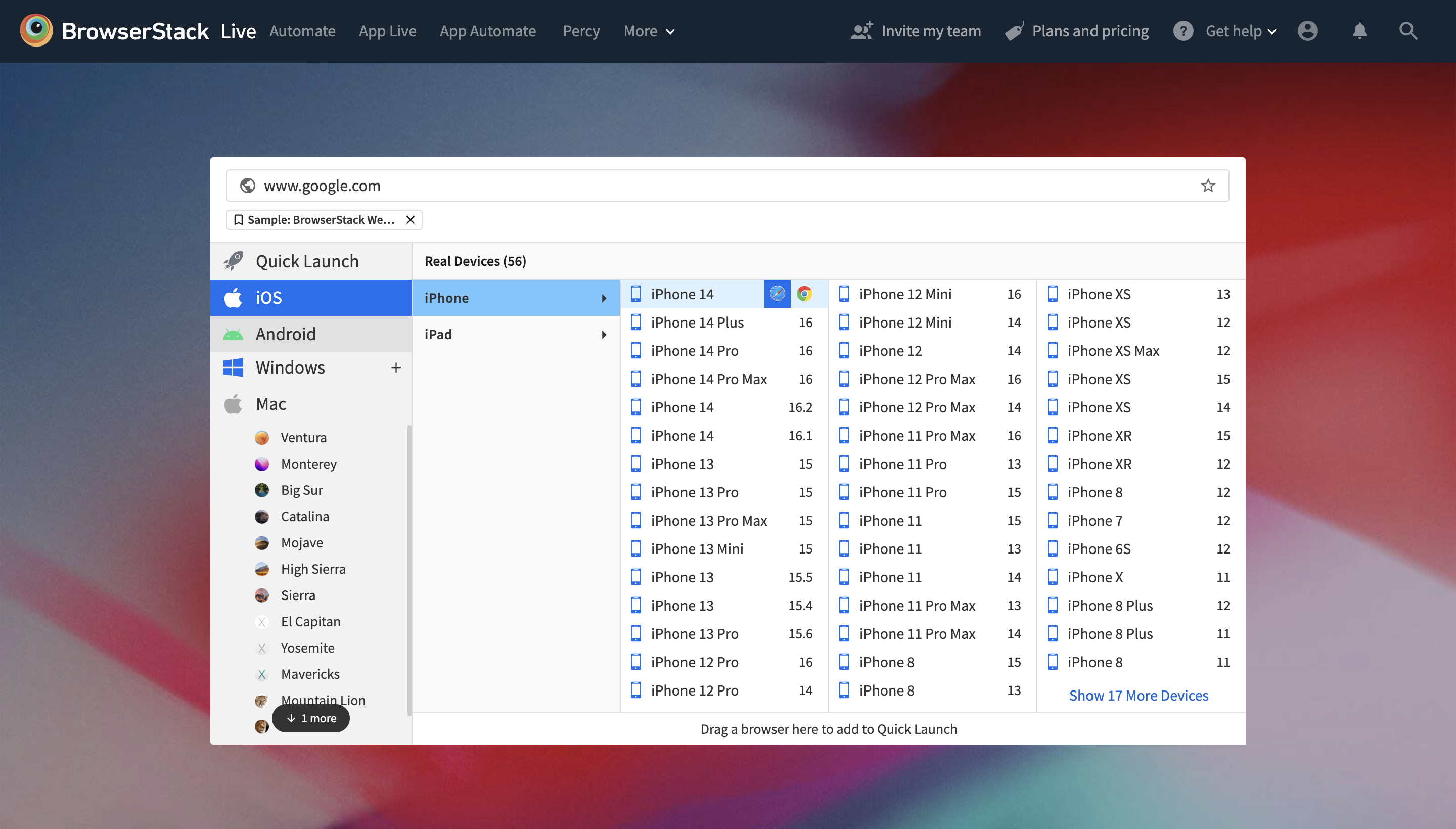
Ensuring sufficient test coverage is essential to release software that meets users’ expectations. It establishes a high-quality user experience and keeps QAs from releasing bug-ridden software into the real world.
Common Challenges in Achieving High Coverage
Achieving high test coverage is a key goal for quality assurance teams—but it’s often easier said than done. Several technical, organizational, and strategic factors can get in the way.
- Incomplete or evolving requirements make it difficult to design comprehensive test cases and often result in missing or outdated tests.
- Time constraints limit the ability to run full test suites or build automation, forcing teams to compromise on coverage.
- Limited test automation prevents scaling test coverage effectively, especially when teams lack the tools or skills to automate.
- Tooling and environment limitations restrict access to real devices, browsers, or realistic test conditions, reducing platform and scenario coverage.
- Low visibility into test and code coverage makes it hard to identify untested areas, leading to blind spots in the testing process.
- High maintenance overhead from large or flaky test suites discourages regular updates, resulting in brittle or unreliable tests.
- Focusing on quantity over quality leads to inflated coverage metrics that don’t reflect real-world usage or critical paths.
- Lack of collaboration across teams causes misalignment in priorities and results in duplicate, conflicting, or missing test efforts.
- Neglect of non-functional testing like performance, accessibility, and security leaves important areas uncovered despite good functional test scores.
- Inadequate API and integration testing causes gaps that UI-level tests alone cannot catch, especially in microservice-based architectures.
Best Practices to increase Test Coverage
Here are the best practices to increase test coverage, written in bullet format without extra spacing — ideal for use in documentation, checklists, or presentations:
- Define clear requirements and acceptance criteria to ensure test cases align with functional and business goals.
- Use a test coverage matrix to map test cases to requirements, user stories, or risk areas and identify coverage gaps.
- Incorporate unit testing early in development to catch logic-level bugs and improve code-level coverage from the ground up.
- Automate high-priority and repetitive test cases to scale testing efforts and ensure consistency across releases.
- Adopt data-driven testing to validate different input combinations, edge cases, and boundary values systematically.
- Include both positive and negative test scenarios to validate how the system handles expected and unexpected inputs.
- Simulate real-world user flows and business scenarios to ensure critical journeys are covered end-to-end.
- Run tests across multiple platforms, browsers, and devices using real device clouds like BrowserStack to maximize environment coverage.
- Measure and monitor test coverage regularly using tools like JaCoCo, Istanbul, or SonarQube to maintain visibility into gaps.
- Integrate automated tests into CI/CD pipelines to ensure consistent and timely execution with every code change.
- Review and refactor test cases periodically to remove redundancy, address outdated logic, and improve maintainability.
- Collaborate across dev, QA, and product teams to ensure shared ownership of test coverage goals and priorities.
- Expand API test coverage to validate backend functionality independent of the UI, especially in service-oriented architectures.
- To ensure complete quality, the coverage strategy should also include non-functional testing (performance, accessibility, security).
Conclusion
Ensuring sufficient test coverage is essential to release software that meets users’ expectations. It establishes a high-quality user experience and keeps QAs from releasing bug-ridden software into the real world.



